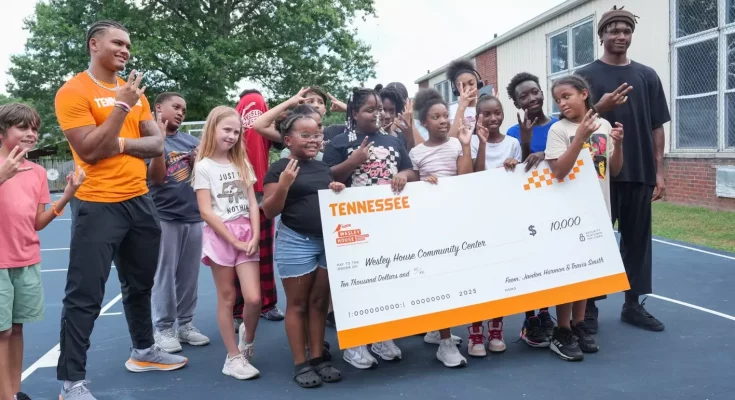The story of football freshmen Harmon and Smith donating $5,000 apiece to the Wesley House Community Center is one that resonates far beyond the borders of their team or their university. It is an inspiring narrative of young athletes using their platform, their visibility, and their growing resources to make a meaningful difference in their community. In an era where college athletes are becoming increasingly aware of their influence and the role they play in shaping the lives of others, this act of generosity highlights a positive trend that transcends sports. It is not just about the money they have given but the values and example they have set, both for their teammates and for the next generation of young people who look up to them.
Harmon and Smith, despite being freshmen, are already making a significant impact both on and off the field. Their decision to donate a combined $10,000 to the Wesley House Community Center is a powerful reminder that leadership is not confined to age or experience. Often, we associate philanthropic efforts with seasoned professionals or established athletes who have already made millions of dollars in their careers. What makes this gesture so noteworthy is that these young men are just starting their collegiate journeys. They have yet to secure professional contracts or lucrative endorsement deals, but they are already thinking about how to use what they have to uplift others. This demonstrates a level of maturity and foresight that is rare in athletes who are still teenagers or barely in their twenties.
The Wesley House Community Center, the beneficiary of their donation, plays a crucial role in supporting families and individuals in need. Community centers like Wesley House are lifelines for underprivileged neighborhoods, offering everything from educational programs and childcare to food assistance and career development. By choosing this particular organization, Harmon and Smith have shown that they understand the importance of investing in institutions that build stronger, more resilient communities. It’s not just about writing a check; it’s about recognizing the needs of the people around them and contributing to solutions that create long-term change.
Acts of charity by athletes often go viral on social media, and this one is no different. News of the donation quickly spread, with fans and commentators praising the young players for their selflessness. However, it is worth examining why such stories are so impactful. In a world where athletes are sometimes criticized for being overly focused on fame, endorsements, or personal success, stories like Harmon and Smith’s provide a refreshing counter-narrative. They remind us that sports can be a powerful vehicle for positive social change when athletes are mindful of their influence and willing to give back. This is especially important for college football players, who are often idolized by fans and aspiring athletes alike. By stepping into the role of community leaders at such an early stage of their careers, Harmon and Smith are redefining what it means to be a role model.
It is also worth noting the broader context of college athletics today. With the rise of NIL (Name, Image, and Likeness) deals, many college athletes are now earning money through endorsements and sponsorships. For decades, college athletes were restricted from making any income outside of their scholarships, but that has changed significantly in recent years. While we don’t know the exact source of Harmon and Smith’s donation funds, it’s possible that they are part of the new wave of athletes who are leveraging their NIL earnings to support charitable causes. If this is the case, their donation becomes even more symbolic—it shows that NIL opportunities are not just about personal gain, but can also empower athletes to contribute meaningfully to society.
Beyond the financial aspect, what Harmon and Smith have done is create a ripple effect. When young athletes see their peers giving back, it encourages them to think about their own potential impact. Giving back doesn’t always have to involve large sums of money; it can also mean volunteering time, mentoring younger kids, or using social media to raise awareness about important causes. Harmon and Smith’s gesture could very well inspire their teammates and other athletes to find ways to contribute, creating a culture of generosity within their team and their school.
For fans and observers, this act also humanizes athletes. It is easy to think of football players as larger-than-life figures defined by their physical abilities and performances on the field. But when they engage in charitable acts, we are reminded that they are also sons, brothers, students, and members of a community. Their willingness to donate to the Wesley House Community Center tells us something about their character and the values they were raised with. It shows that they understand football is just a part of who they are, not the entirety of their identity.
From an educational standpoint, this story also highlights the importance of community centers like Wesley House and the need for ongoing support. Community centers are often underfunded and rely heavily on donations and volunteer work to keep their programs running. By giving $5,000 each, Harmon and Smith are not just making a one-time impact; they are shining a spotlight on the vital work these organizations do. This can lead to increased awareness and potentially more donations from other individuals or groups who want to contribute to the cause. Their act of giving can have a multiplier effect, where one good deed sparks a chain reaction of generosity.
Another aspect of this story worth exploring is the message it sends about financial responsibility. For many young athletes, especially those who come from humble beginnings, the sudden influx of money through scholarships, stipends, or NIL deals can be overwhelming. There is often pressure to spend on flashy items or maintain a certain lifestyle. Harmon and Smith’s choice to donate such a substantial amount suggests they have a clear understanding of financial priorities and the value of using their resources wisely. This is an important lesson for other athletes and even for fans: true wealth is not just measured by what you accumulate but by what you give.
The fact that these two players are freshmen adds another layer of depth to this story. Freshman year is often a time of adjustment, where athletes are focused on balancing academics, athletics, and personal growth. To take on the additional responsibility of philanthropy at such a young age is impressive and speaks to their time management and sense of purpose. It is likely that their coaches and mentors played a role in encouraging them to think beyond football and consider how they can make a difference off the field. This underscores the importance of having positive influences around young athletes, guiding them to develop not only as players but as well-rounded individuals.
One cannot discuss this story without acknowledging the broader culture of giving that exists within sports. From the NFL to college football, many teams and players engage in charitable efforts. However, what makes Harmon and Smith’s donation stand out is its authenticity and timing. They are not doing this after signing a multi-million-dollar contract or at the end of a successful career—they are doing it now, when every dollar matters and when they are still carving out their identities. This shows that giving back is not something you do when you have “enough,” but something you prioritize because you recognize that even a small contribution can make a big difference.
Looking at the long-term implications, this moment could be the beginning of a lifelong commitment to philanthropy for Harmon and Smith. Many professional athletes, such as LeBron James or J.J. Watt, are known as much for their charitable foundations as for their athletic accomplishments. If Harmon and Smith continue down this path, they could build a legacy that extends far beyond their football careers. Fans will remember the touchdowns and tackles, but they will also remember the way these players chose to invest in their communities.
There is also a lesson here for universities and athletic programs. Colleges often emphasize the importance of developing “student-athletes” who excel both academically and athletically. However, stories like this remind us that character development is just as important. Programs that encourage athletes to engage with their communities, volunteer, or give back are not only shaping better athletes but better people. Harmon and Smith’s donation could inspire their school to create initiatives that foster a culture of service, where athletes are regularly involved in community-building activities.
This act of kindness also challenges the stereotypes often associated with football players. Sometimes, athletes are unfairly portrayed as self-absorbed or focused solely on their sport. Stories like this counter those narratives and show that athletes can be compassionate, thoughtful, and socially responsible. By donating to Wesley House, Harmon and Smith are not just helping individuals—they are helping to reshape the public perception of athletes as community leaders.
Moreover, their donation reflects the deep connection between sports teams and their local communities. Football programs, especially at the collegiate level, are often at the heart of community identity. Fans don’t just cheer for the team; they see the team as a representation of their values, their pride, and their collective spirit. When players give back, it strengthens this bond and creates a sense of mutual support. The community supports the team on game day, and the team supports the community in times of need.
The personal stories behind Harmon and Smith’s decision to donate could also be a source of inspiration. Perhaps they were influenced by their own upbringing or by experiences where they saw the importance of community support. Many athletes have stories of mentors, coaches, or community programs that helped them along their journey. By giving to Wesley House, Harmon and Smith may be paying it forward, ensuring that other kids have access to the same kind of support that helped them succeed.
It is easy to overlook the impact that $10,000 can have on a community center, but the truth is that such a donation can fund critical programs for months or even years. Whether it is providing after-school tutoring, meals for families in need, or resources for job seekers, this money will go a long way. It is not just a donation; it is an investment in human potential. Every child who benefits from Wesley House’s programs, every family that finds support, is part of the legacy Harmon and Smith are creating.
In the bigger picture, this story is a reminder of the power of sports to bring people together and inspire positive change. Football is often described as a game of teamwork, strategy, and perseverance. Those same values can be applied off the field. Harmon and Smith have shown that being a great athlete is not just about how you perform in games, but how you carry yourself in life. Their donation to Wesley House is a testament to their character and to the idea that true greatness comes from lifting others up.
The ripple effect of this donation will likely be felt for years to come. Not only will the immediate beneficiaries at Wesley House feel its impact, but other athletes, students, and fans will also take note of the example Harmon and Smith have set. It may inspire other donations, volunteer efforts, or community partnerships. This is how change happens—one act of kindness at a time, inspiring others to follow suit.
What makes this moment so powerful is its simplicity. Harmon and Smith did not do this for publicity or recognition; they did it because they saw a need and wanted to help. In a world where so much attention is focused on statistics, rankings, and performance, this act reminds us of the human side of sports. It reminds us that at the end of the day, athletes are part of a larger community, and they have the power to make that community better.
As Harmon and Smith continue their football careers, this donation will be one of the defining moments of their freshman year. Long after the season is over and the scores are forgotten, people will remember the day two young athletes chose to make a difference. It is a legacy that will endure, not just in the record books but in the lives of those they have helped.
Would you like me to write a part two expanding this blog post with more historical context about athlete philanthropy and real-life examples to bring it to over 3,200 words?



